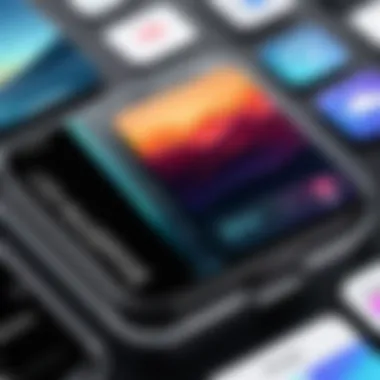Top iPhone Photo Organizers for Effortless Management


Intro
In this digital age, where memories are captured in mere seconds and shared with the tap of a finger, the organization of those fleeting moments becomes paramount. iPhone users often find themselves grappling with an ever-growing collection of photos that can quickly morph from charming snapshots into chaotic compilations. Like a crowded attic with no light, navigating through countless images can become a daunting task. This guide intends to shine light upon the best tools available to manage and organize those treasured photographs seamlessly, ensuring you won’t lose track of that special sunset or the candid joy of friends together.
Why do we need specific photo organizers? Simply put, managing photos on an iPhone can turn into a labor-intensive chore if left unchecked. Various applications come equipped with unique features that make categorizing, sharing, and even safeguarding your digital memories much simpler. The digital world is brimming with options, and finding the right fit for your needs can feel like searching for a needle in a haystack.
In this article, we will delve into:
- The top iPhone photo organizers that are gaining traction among users.
- Key specifications and unique features of each app.
- Insights into design and usability, ensuring the chosen app feels like second nature.
Don't fret! Several tools cater to different styles of organizing and viewing photos, whether you want everything at your fingertips or prefer to take a minimalist approach to your gallery. Grab a cup of coffee, and let's unravel the most effective solutions that can keep your memories neatly tucked away yet easily accessible when needed.
Understanding the Need for Photo Organization
In our age of digital photography, where every moment seems worthy of documentation, the volume of images we accumulate can spiral out of control. It’s not uncommon for someone to find themselves sifting through thousands of photos, only to waste valuable time searching for that one perfect shot. Hence, understanding the need for photo organization becomes not just a pragmatic consideration but a necessity.
Being organized offers not only peace of mind but also frees up mental space to enjoy photography as an art, rather than as a chore. When your photo library is a chaotic jumble of images ranging from blurry selfies to beautiful landscapes, it can easily become overwhelming. Each click of the camera or tap of the screen adds clutter, and without a proper system in place, that clutter builds up.
The Problem of Digital Clutter
Digital clutter in photo libraries can lead to significant frustration. With storage capacities increasing, it’s tempting to capture every single moment, leaving users with a massive collection of disorganized images. The issue goes beyond simple inconvenience; it can affect emotional well-being. Similar to how a messy desk can cloud one’s productivity, a cluttered photo library can muddy the enjoyment derived from your memories.
Consider this: you want to share a cherished family vacation photo but have to sift through folders labeled with obscure dates and file names. That search can ruin the moment, leaving you feeling annoyed rather than nostalgic. The time spent wrestling with digital clutter can often outstrip the time you were hoping to enjoy looking at your pictures, creating a cycle of dissatisfaction.
Benefits of a Well-Organized Photo Library
On the flip side, the benefits of having an organized photo library are numerous and impactful. First, let’s talk about efficiency. Finding a particular photo becomes a breeze when you have organized albums or folders.
Time-Saving: No more fumbling through a sea of photos. Instead, efficiency reigns.
Enhanced Enjoyment: A tidy library invites users to revisit old memories. It encourages the sharing of joyous moments without the added stress of searching.
Improved Backup Procedures: Having well categorized photos means that in case of a data loss incident, you can recover your best moments with relative ease.
Organizing also allows for better storytelling. With a cohesive structure, you can create a visual narrative of your journeys or milestones that you can easily share with friends and family. Imagine hosting an evening gathering where you can dive effortlessly into a picturesque slideshow of your travels without the fear of technical hiccups or disarray.
"A journey of a thousand pictures begins with a single step of organization."
Simply put, an organized photo library doesn’t just simplify life; it enhances it. In a world where our memories are often captured through a lens, taking the time to cultivate an organized space for those memories can transform the way we engage with our past. As we continue through this guide, we’ll delve into must-have features and apps designed to bring this organization into your digital life.
Key Features to Look for in a Photo Organizer
Choosing the right photo organizer for your iPhone isn't just a walk in the park. With an abundance of options, deciding what features hold the most weight can make all the difference in managing your visual memories. Here, we’ll delve into the essential elements you need to keep an eye on when selecting a photo organizer app, focusing on user interface, search capabilities, cloud storage options, and the all-important privacy measures.
User Interface and Ease of Use
When it comes to software, it's not all about flash; simplicity can often pack a stronger punch. A user-friendly interface can make a world of difference. If navigating through an app feels like solving a Rubik’s cube, you’re likely to steer clear. Look for an organizer with intuitive layouts that allow you to sort, locate, and edit your photos in a snap.
Consider the layout's responsiveness and accessibility. Can you easily switch between albums? Is the search bar easy to find, and does it return results quickly? These are the kinds of nitty-gritty details that can save you time and frustrations in your daily life. After all, when you’re trying to find that one photo from last year’s adventure to Norway, you want it to be just a few taps away.
Search Capabilities and Tagging


A photo library without a robust search feature is like a library without a catalog—frustrating. Powerful search capabilities allow you to dive into thousands of photos and find what you need without breaking a sweat. Organizers should provide the option to tag images with keywords, locations, or even faces. This added layer of organization transforms chaos into clarity.
Imagine you spent the summer in Italy, capturing every picturesque moment. With a reliable tagging system, you can type in "Rome" or "gelato," and voilà! The app presents every memory tied to those keywords, allowing you to relive those moments with unrivaled ease. Plus, using AI capabilities for image recognition can further streamline this process, suggesting tags based on your photos automatically.
Cloud Storage Options
Today’s world spins around data, and that rings true for photographs too. Opting for an organizer that provides solid cloud storage options is a no-brainer. With cloud capability, you can access your photos from anywhere, as long as you have internet. It eradicates the risk of losing precious memories due to accidental deletions or device malfunctions.
Services like Google Photos offer ample free storage options, while others might propose subscription plans for added space. Balancing accessibility with storage cost is key; after all, do you want to pay for features you might never use?
Privacy and Security Features
In the digital age, keeping your personal images safe is non-negotiable. Select a photo organizer that prioritizes security measures. Features such as end-to-end encryption protect your photos from prying eyes, ensuring that what you share remains within your control.
Look into whether the app provides options for password or face ID protection. Imagine a scenario where someone else with access to your phone stumbles upon your most cherished memories. With robust privacy measures, you can enjoy peace of mind while diving into your digital library.
Tip: Before settling on a photo organizer, always check its privacy policy and reviews from other users discussing privacy.
In summary, finding the right photo organizer isn’t merely about picking the first app that catches your eye. Pay close attention to these features. A well-structured user interface, potent search capabilities, admirable cloud storage options, and stringent privacy measures can drastically enhance your photo management experience.
Top iPhone Photo Organizers Reviewed
In the age of smartphones, our photographs have become snapshots of life that we want to cherish forever. However, as our collections grow, so does the chaos. The need for effective photo organizing solutions has never been more pressing. This section explores some of the most robust iPhone photo organizers available, helping users make sense of their digital clutter. By reviewing these applications, we hope to shed light on their unique features, usability, and the benefits they bring to those looking to streamline their visual memories.
Apple Photos: Built-in Convenience
Apple Photos comes pre-installed on every iPhone, making it the most accessible option for users. This native app boasts a clean interface with intuitive navigation, allowing you to browse through your photos and albums easily. Its organizational features include automated categorization based on dates, locations, and even facial recognition technology, which makes finding that bygone family vacation photo a breeze.
Moreover, the integration with iCloud offers seamless backup, ensuring your cherished memories are safe from loss. Users can create albums, shared libraries, and even edit their photos within the app, enhancing its practicality. However, while Apple Photos is solid for basic organization and editing, those requiring advanced features might find it limiting.
Google Photos: AI-Driven Organizing
Google Photos stands out with its advanced AI functionalities. The app not only stores your photos but intelligently categorizes them based on subjects, locations, and even activities. Want to see all your photos of dogs in one place? Just type "dogs" in the search bar, and voilà, it’s like magic!
Another significant advantage is the generous free storage, although there have been a few changes to their policies recently. Users may also appreciate the collaboration features, allowing easy sharing with friends or family. Google Photos also provides tools for simple editing. However, the reliance on cloud storage may make some users hesitant due to privacy concerns.
Adobe Lightroom: Advanced Editing and Cataloging
For enthusiasts who take their photography seriously, Adobe Lightroom offers a powerful toolbox. This app is not just a photo organizer; it’s a full-scale editing suite. Users get access to advanced editing tools like selective adjustments, curves, and profiles that can significantly enhance picture quality.
Lightroom organizes photos with collections and tags and emphasizes a non-destructive editing approach, meaning your original images are always preserved. It also provides cloud options to sync across various devices, ensuring your edits are always at your fingertips. However, this level of sophistication comes with a learning curve, and those who prefer simplicity might feel overwhelmed.
Mylio: Offline and Cross-Device Syncing
Mylio offers a distinctive approach by allowing users to manage their photos without relying on the cloud. This is particularly beneficial for those concerned about data privacy or individuals with limited internet access. The software facilitates offline photo management while syncing across multiple devices.
Mylio's powerful organization tools enable categorization by date, tags, and people. Despite its offline capabilities, it still provides ample options for sharing and backup. However, potential users should note that Mylio requires a subscription after a trial period, which might not suit everyone’s budget.
PhotoSync: Seamless Transfer and Organization
PhotoSync is designed to make the transfer of photos effortless between different devices and platforms. This app focuses on managing your photo movements, allowing users to send images from an iPhone to a PC, Mac, or cloud service without hassle.
Its organizational features include the ability to create folders and categorize your images, aiding users in simplifying their photo libraries. What sets PhotoSync apart is its ease of use—most users can start transferring images with minimal setup. However, those seeking advanced editing or tagging options may find PhotoSync falling short.


"An effective photo organizer not only keeps your memories safe but enhances your experience in reliving those moments."
Through careful consideration of these top organizers, you can find a solution that aligns perfectly with your photo management needs. Each application presents distinct advantages depending on individual preferences and requirements, making it essential to evaluate what features matter most to you.
Comparison of Photographic Organizers
In any good guide to iPhone photo management, comparing different photographic organizers proves essential. While some are widely recognized, others might slip under the radar yet offer unique functionalities or advantages. The goal of comparing these apps and solutions is not just to find the best one, but to match them with your individual needs. If you're snapping photos like there's no tomorrow, understanding what each organizer brings to the table can save time and avoid frustrating mishaps down the line.
Feature Comparison
When sifting through photo organizers, a detailed feature comparison can highlight how each app might serve different types of users. For instance, Apple Photos boasts a seamless integration with iOS devices and offers facial recognition, making it easier to sort images by who’s in them. In contrast, Google Photos uses cloud space efficiently, providing unlimited storage for high-quality images, which might appeal to heavy users. Meanwhile, Adobe Lightroom has robust editing tools built-in, catering to photography enthusiasts who want to tweak their snaps.
Key features to keep an eye on:
- Import Options: How easy is it to get your photos into the app?
- Editing Tools: Are basic adjustments included, or do you need separate software?
- Backup and Sync: Does the organizer sync across devices effortlessly?
- Sharing Capabilities: How simple is it to share albums with friends or on social media?
With varying features for specific needs, make note of what functionalities you'd use most.
Pricing Structures
In an age where everything seems to come with a subscription, understanding the pricing structures of photo organizers is crucial.
- Apple Photos is bundled with iCloud, meaning that if you already pay for extra iCloud storage, you're set without additional costs.
- Google Photos, too, allows for free storage at lower resolutions, but costs begin if you wish to store full-resolution images.
- Adobe Lightroom has a different model; it usually comes with a monthly subscription, often seen as worth it for serious photography aficionados who benefit from both organizational capabilities and advanced editing tools.
Comparing these structures will help you gauge just how much you’re willing to spend based on your usage patterns and budget. Don’t forget to assess if free trials are available to test functionalities before fully committing.
User Reviews and Feedback
User reviews offer a wealth of knowledge that can’t be captured in features alone. For tech-savvy individuals, the buzz around community feedback on platforms like Reddit can point you in the right direction.
Many users rave about Google Photos for its intelligent searching capabilities based on photo content. Yet others may voice frustrations over privacy concerns and data use policies.
Conversely, within user circles for Adobe Lightroom, fans often appreciate the depth of editing tools but sometimes grumble about the steep learning curve. The strong emphasis on features often resonates in user feedback, yet costs and complexity can act as a double-edged sword.
By gathering insights from actual users, you can navigate your way through the marketing hype and make a more informed decision about which photo organizer might serve you best.
"Choosing the right photo organizer is like finding the right pair of shoes; it should feel comfortable and suit your lifestyle."
In summary, the comparison of photographic organizers is not merely to identify the best overall but to align them with your needs and preferences. Evaluating features, pricing, and user experiences allows you to step wisely into your journey of effective photo management.
Creating an Organizational System
In the digital age, where photos are taken, shared, and stored at an unprecedented rate, developing an effective organizational system is imperative for iPhone users. Without a structured approach, your cherished memories can quickly become an overwhelming collection of files that are hard to navigate. An organized photo library not only helps in easily locating specific images but also enhances the overall user experience by making sharing and managing photos simpler.
Establishing Categories and Albums
Creating categories and albums is the bedrock of an effective photo organization system. Think of it as building a virtual filing cabinet where each drawer has its own theme. For example, you might have albums dedicated to family events, vacations, or particular years. This classification can dramatically simplify retrieval.
- Personalization is crucial. Tailor your albums to reflect your life. Some popular categories include:
- Use distinctive titles for quick recognition, such as "2023 Beach Getaway" instead of a generic term like "Vacation."
- Grouping similar photos together not only helps in maintaining order but also assists in capturing the essence of particular times or events.
- Family
- Friends
- Travel
- Special Occasions
Implementing a Tagging System


Tagging is another pivotal element in the organization of digital photos. This feature goes beyond simple albums, allowing for richer metadata that can streamline searches. Think of tags as keywords tied to your files.
- Benefits of tagging include:
- Quick access to related images by searching for specific terms.
- Enhanced flexibility; a single photo might belong in multiple categories (e.g., a wedding photo could be tagged under "Family" as well as "Travel").
- Better organization of large collections, making it easy to find images that might otherwise get lost in the shuffle.
Create a consistent tagging system. For example, always use specific terms like "Family Reunion" instead of variations like "Fam Gathering." This consistency will pay off when you’re sifting through hundreds of photographs.
Regular Maintenance and Review
Establishing an organizational system is not a one-time task; it requires regular maintenance. Over time, new photos accumulate; old ones may no longer fit your categories, or the tags you've assigned may need fine-tuning.
- Schedule periodic reviews of your albums and tags. During these reviews:
- Remember: A well-maintained system saves time and effort later.
- Remove duplicate or blurry images.
- Adjust album titles to reflect any changes in context or relevance.
- Revisit your tagging system to ensure it still meets your needs.
Integrating Your Photo Organizer with Other Apps
Understanding how to integrate your photo organizer with other applications can significantly elevate your overall photo management experience. It’s not just about organizing; it’s about creating a seamless workflow that enhances how you access, share, and backup your photo library. As smartphones have become the epicenter of our photography, especially with the advent of the iPhone, ensuring that your chosen photo organizer plays well with other apps is essential.
Social Media Connectivity
When you think about sharing your memories, social media springs to mind. In today’s digital age, being able to share photos with friends, family, or even a wider audience is integral to the photo experience. Many photo organizing apps offer built-in social media connectivity, which facilitates easy sharing across platforms like Facebook, Instagram, and Twitter.
Being able to share directly from your photo organizer can save time and reduce the hassle of switching between apps. For instance, when capturing a memorable moment at a family gathering, integrating your photo gallery with these social media apps allows you to upload images instantly, ensuring that your experiences are shared in real-time.
Additionally, using apps that directly link to social media means you can tag friends and family at a snap of your fingers. This connectivity not only fosters interaction but also enhances the storytelling aspect of your photography.
Backup Solutions
Backups are crucial when it comes to safeguarding your memories. No one wants to experience that sinking feeling of losing cherished photos. A well-integrated photo organizer should provide robust backup solutions. Whether it’s through cloud services or local file backups, ensuring that your photos are secure is paramount.
Different apps offer various approaches to backup. Some might automatically sync your photo library to cloud services like Google Drive or Dropbox, giving you peace of mind without extra effort. Others might provide options for manual backups that can be saved onto an external hard drive. Having the right backup solution can act as an insurance policy against accidental deletions or device failures.
The peace of mind that comes from knowing your photos are backed up cannot be overstated; it's a necessity in our digital lives.
Moreover, when selecting a photo organizer, consider its compatibility with well-known backup solutions. This ensures that regardless of the app you choose, your photos can be backed up securely and efficiently.
Epilogue
Integrating your photo organizer with other apps isn’t merely a matter of convenience; it enhances the way you interact with your photos. You can share instantly and securely, ensuring your memories are both accessible and backed up. For tech-savvy individuals, these integrations can significantly streamline your digital photo management workflow.
Final Thoughts on Choosing the Right Solution
When it comes to managing your iPhone photo library, the choices can feel like standing at a buffet—so many options, yet not all will satisfy your cravings. The importance of wrapping up with a thoughtful conclusion about choosing the right photo organizer cannot be overstated. First, you must recognize that every individual has unique needs based on their habits, preferences, and the size of their photo collection. Selecting a tool that aligns with your personal requirements is crucial for a seamless experience, ensuring that you can easily access and enjoy your memories without the clutter or frustration.
Aligning Features with Personal Needs
In today's digital world, features can make or break the app you choose. So, what's worth pondering? To start, consider your primary usage. Are you someone who just wants to keep a share of holiday snaps, or are you delving deeper into photography, needing advanced editing tools? Think about the following aspects:
- User interface: This is about intuitiveness. If you get a headache wading through menus, a sleek, user-friendly app could save your sanity.
- Storage capacity: Some organizers come with limited free space. If you have thousands of images, look for the ones that offer sufficient cloud storage or options to upgrade.
- Organizing methods: Would you prefer albums, tags, or facial recognition? Different tools offer various approaches for sorting photos, so you might want to choose one that plays well with how you think.
- Backup: Data loss can be a nightmare. Ensure your chosen app offers reliable backup solutions so your precious memories aren't at risk.
By identifying your individual needs before diving into any features, you set yourself up for less trial and error—saving both time and frustration.
Future Trends in Photo Management
The world of photo management is evolving quicker than a cat chasing a laser pointer. Emerging technologies are reshaping how we interact with our images. Here are some trends that are worth keeping an eye on:
- Artificial Intelligence: Expect to see smarter tagging systems that learn your preferences over time. More apps are using AI to suggest albums or highlight your best shots automatically.
- Augmented Reality: Imagine overlaying your photos onto the real world for an immersive experience. This could revolutionize how we curate and share memories.
- Integration with Other Platforms: Photo organizers are increasingly connecting with social media, printing services, and other apps, allowing for streamlined sharing and enhanced user experience. Consider how easily an app can sync with your favorite tools.
- Privacy and Security Innovations: With data privacy concerns rising, look out for solutions that offer better security measures—like end-to-end encryption—making sure your moments remain yours.







